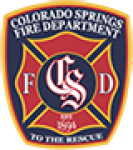The following information was developed from a collaborative effort between the Housing and Building Association (HBA), the Affiliated Commercial Contractors Association (ACCA) and the Colorado Springs Fire Department (CSFD) in an effort to better define what is expected and accepted regarding emergency service access on construction sites. This information is intended to provide "performance" measures rather than "prescriptive" measures.
2021 COLORADO SPRINGS FIRE CODE
DEFINITION
Temporary fire access road. Temporary access roads shall be an all-weather surface comprised of either the first lift of asphalt or concrete/compacted gravel to a thickness capable of supporting the imposed loads of fire department apparatus. A 20-ft minimum width shall be maintained unless the permanent road is designed less than 20-ft, in which case the temporary road shall be the intended width of the permanent road. Adequate street signs and fire lane signs shall be installed where applicable. Temporary access roads must be maintained in accord with this section. Temporary access roads serving as fire lanes shall not be in place for more than 6 months without special approval from the fire code official.
ACCESS FOR FIREFIGHTING
All construction sites within the City of Colorado Springs shall be required to provide fire department access per Section 3311 of the 2021 International Fire Code as amended.
Site development managers and/or building construction superintendents shall have the responsibility to monitor emergency service access conditions on a daily basis. When conditions are such that emergency service access is diminished in minimum required width, capability of carrying imposed loads and/or providing adequate traction, appropriate measures shall be taken to mitigate such conditions to once again provide adequate emergency service access. Fire Inspectors have the authority to make decisions regarding access conditions and adequacy of mitigation measures.
Required access. Approved vehicle access for firefighting shall be provided to all construction or demolition sites. Vehicle access shall be provided to within 100 feet of temporary or permanent fire department connections. Vehicle access shall be provided by either temporary or permanent roads, capable of supporting vehicle loading under all weather conditions. Vehicle access shall be maintained until permanent fire apparatus access roads are available.
Temporary access roads shall be an all-weather surface comprised of either the first lift of asphalt or concrete/compacted gravel to a thickness capable of supporting the imposed loads of fire department apparatus. A 20-ft minimum width shall be maintained unless the permanent road is designed less than 20-ft, in which case the temporary road shall be the intended width of the permanent road. Adequate street signs and fire lane signs shall be installed where applicable. Temporary access roads must be approved and inspected by the fire code official and maintained in accord with this section.
Examples of conditions that could diminish adequate emergency service access include, but are not limited to:
- Rutted drive aisles
- Standing water on drive aisles
- Conditions that promote limited traction such as
- Mud, ice, snow, etc.
- Small gravel or similar materials in large enough quantities atop a hard surface along a slope
- Wet leaves
- Obstructions within the 20-ft drive aisle such as
- Stored construction materials
- Construction activities such as utility installations
- Construction vehicles
Examples of actions that could be taken by site development managers and/or building construction superintendents to mitigate inadequate emergency services access include, but are not limited to:
- Blading of access drives
- Filling of ruts, holes, etc. with appropriate materials
- Removal of snow, ice, etc.
- Relocation of or providing designated storage areas for construction equipment, materials, etc.
- Closure of construction site until conditions improve. Failure to mitigate inadequate emergency service access may result in a summons issuance. Continued failures may result in termination of all construction site activities, with the exception of those activities needed for mitigation, until mitigation is completed.
Emergency responders will do everything within their abilities to gain access to or onto the site in order to mitigate an emergency. However, if adequate emergency service access is not maintained as required, the development company and/or building construction company may be cited for inadequate access.
Fire Inspectors may deny fire inspections if adequate emergency services access is not maintained and the site is inaccessible. This may result in additional inspection fees and/or termination of all construction site activities.
Please direct any questions to the Division of the Fire Marshal at 719-385-5978.

